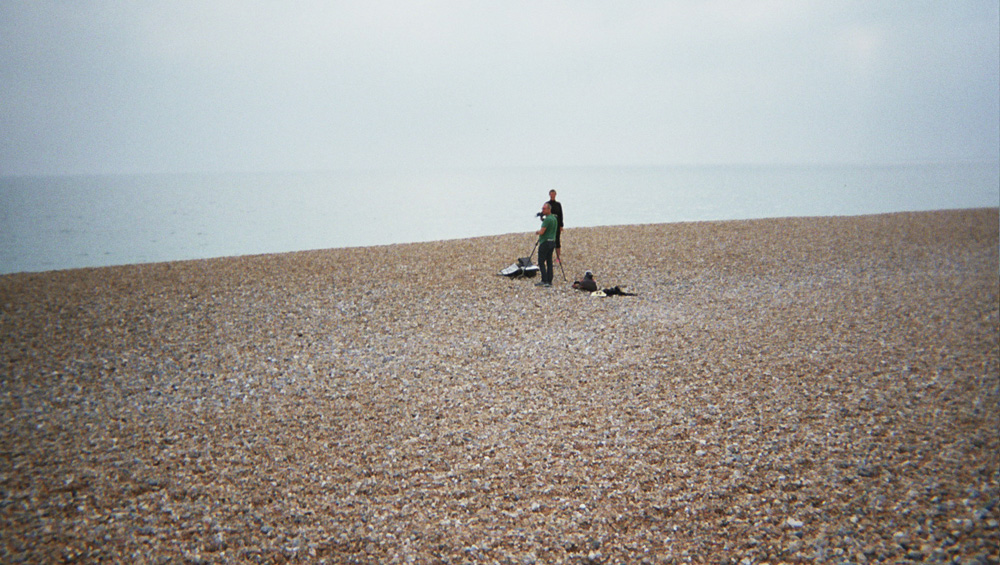
Documentation of the making of an Assisted Self-Portrait from Assembly (2013-2014) by Anthony Luvera.
by NICOLA HOMER
“I grew up on a diet of neo-Marxist critiques of documentary photography written by Allan Sekula, Martha Rosler and AD Coleman. They called on the documentary photographer to think more critically about their ability to convey truth and reality, and to think about their subject position within, or outside, the life experience of those that they represent,” says Anthony Luvera (b1974, Australia), a socially engaged artist, recounting his experience of studying at university in Perth in Western Australia. His interest in photography began when he was 14 and his uncle, who was a private investigator, loaned him photography equipment. Along with his best friend, Luvera was gifted darkroom equipment by one of his schoolteachers, and they took out an advert in their local newspaper, offering to teach people about photography. After obtaining a BA in photomedia from Edith Cowan University, he began to forge a career in fashion photography. Yet when he moved to the UK in 1999, his career took an educational turn.
Since 2001, Luvera has worked with people who have experienced homelessness in cities and towns across the UK. The collaborative projects he has created have been exhibited internationally in museums and public spaces. A breakthrough moment came with his exhibition of his Assisted Self-Portraits in central London, for Platform for Art, now known as Art on the Underground. After gaining wide recognition, Luvera became interested in ethics and community photography. This led to his collaboration with Belfast Exposed, an organisation founded in 1983 by a collective of photographers concerned at how Belfast and the Troubles in Northern Ireland were being represented, largely by photojournalists from elsewhere around the world. Since producing an exhibition called Assembly at the Brighton Photo Fringe in 2014, Luvera has developed a project entitled Frequently Asked Questions. The 2017 edition was launched at Tate Modern and later exhibited at Tate Liverpool. In November, he will hold an exhibition at the People’s Republic of Stokes Croft in Bristol. He is course director of the master’s degree in photography and collaboration at Coventry University.

Cover of Photography for Whom? – Issue 1, June 2019.
This summer, at the Blast! festival of photography in the West Midlands, Luvera launched Photography for Whom?, a twice-yearly journal that he has edited, which is supported by Grain and Multistory. The journal has a readership of students, practitioners, curators and historians from across the arts and humanities. Luvera says: “Photography for Whom? seeks to celebrate the community photography projects and practices of the past that were significant and perhaps are now lesser-known. At the same time, it seeks to commission writing that reflects on the legacy of that time, while also considering contemporary socially engaged practice as a way to enable consideration of the practical, theoretical and methodological issues involved in this way of working.”
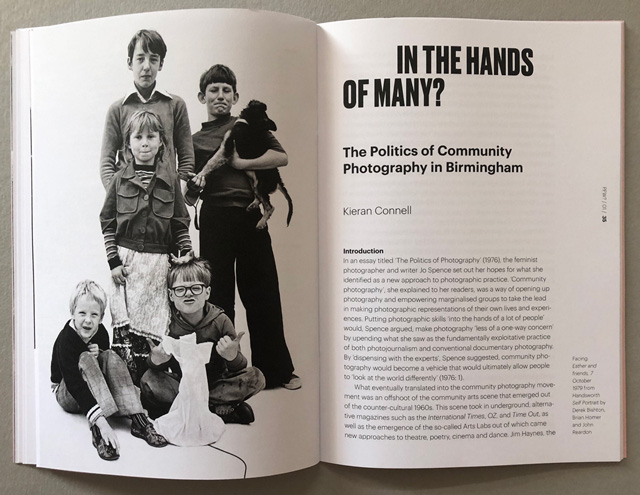
Detail of Photography for Whom? – Issue 1, June 2019.
The following text is an edited excerpt from an interview with Studio International, in which Luvera discusses the journal, the influence of community photography in an era of changing technology, and his recent project Frequently Asked Questions.
Nicola Homer: In the introduction to the journal, you write that: “Photography for Whom? seeks to shine light on community photography of the past as a way to consider socially engaged photographic practice today.” As a jumping-off point, the journal takes the concept of community photography. For the benefit of Studio International readers, can you tell me what this means, and how it helps to look at photographic practice today?
Anthony Luvera: The community photography movement gathered momentum in the 1970s. It grew out of the leftwing radical politics of post-1968 cultural expressions, fuelled by a belief that by enabling people who perhaps didn’t have access to art and other forms of cultural expression, it could enable a form of cultural democracy. Often within community support services in towns and cities across the UK, there was a photography project. Notable examples include the Cockpit Arts workshop and the Blackfriars Photography Project, which were both in London. There is also Belfast Exposed, the Cambridge Darkroom, and Amber and Side Gallery in Newcastle. Perhaps one of the better-known projects here in London was the Half Moon Photography Workshop, which later became Camerawork.

Detail of Photography for Whom? – Issue 1, June 2019.
When I arrived in London in 1999, one of the ways in which I took up work was as a freelance educator within community photography projects. A number of the places I worked for grew out of these kinds of community photography projects of the 70s and 80s, places such as Photoworks Westminster, which evolved out of the North Paddington Community Darkroom; Photofusion in Brixton, which was built on the Wandsworth Photo Co-op; and Zoom In, which grew out of the women’s photography collective Monochrome. Working as a community photography educator for these organisations with longer histories of working with people who were largely non-photographers to say something about their environments and their concerns, as well as to develop new skills, fascinated me greatly.
Around 2001, I was invited by someone who worked at a homeless charity to take photographs of people at a large shelter event over the Christmas period, called Crisis Open Christmas. The invitation was to make images as a point-and-shoot photographer and I quipped: “You know, I’d prefer to see what the people I met would make photographs of.” Afterwards, I was doing consultation work for Kodak on its single-use cameras and this put me in the perfect position to access resources. I began to facilitate workshops with people who were experiencing homelessness to make images of their lives and the things they were interested in. While developing my practice in this way, I was aware of the fact that a lot of the ways of working I was engaging with had been explored within this field of practice called the community photography movement, but that those projects weren’t clearly written up in the main accounts of photography. That sat as a puzzle in my mind.
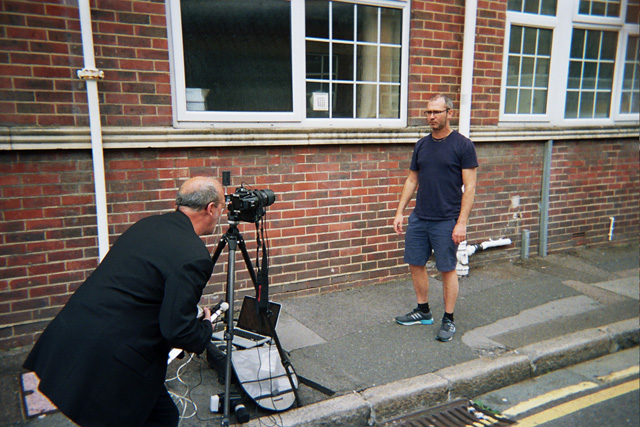
Documentation of the making of Assisted Self-Portrait of Fred Clarke, from Assembly (2013-2014) by Anthony Luvera.
Since then, I have continued to work with homeless people in towns and cities around the UK, as well as many other community groups, developing my socially engaged photographic practice through forms of co-creation, collaboration and participation. Over this time, I’ve noticed generations of younger photographers forge their own paths in a similar way, who may not be aware of the rich history of the community of practice that precedes them. The idea behind Photography for Whom? is to take a piece of writing about a project, a practice or a theme from the community photography movement, to republish it, and to commission a new piece of writing that looks at its contexts, connections and legacies in relation to contemporary socially engaged photography. It’s a gesture towards forging accounts that seem to be missing elsewhere.
NH: That’s amazing. How do you think it helps to look at socially engaged photographic practice today?
AL: One of the things about any kind of social practice, whether it be within the expanded field of photographic practice, or another art form such as applied theatre, is a tension between the process of working with participants and the products that are created and then circulated to audiences. To look at what is made within any form of social practice as being solely the outcome is to disavow the unique dialogue that the practice hinges on. Photography, of course, is a medium about freezing time, and translating that to a two-dimensional composition. It has a particular set of challenges around how it can represent the temporality of a socially engaged practice. For me, in approaching any form of socially engaged photographic practice, there is a particular set of questions one should ask around the politics of representation and the ethics of collaboration.
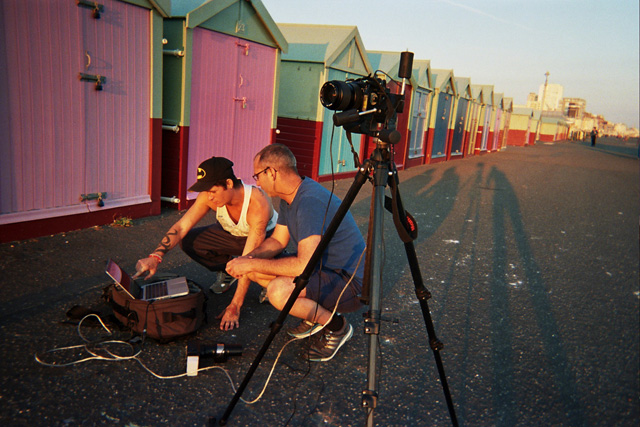
Documentation of the making of Assisted Self-Portrait of Ben Evans, from Assembly (2013-2014) by Anthony Luvera.
NH: It is interesting what you say about the ethics of socially engaged photographic practice as being important. I imagine that, reading about the history and the context of community photography offers present-day practitioners a greater insight into ethical considerations.
AL: I hope that by reading about how community photography practitioners of the past negotiated or developed their work, anyone interested in socially engaged photography today will be able to reflect on the understandings they bring to their own work. In the introduction of the first issue of Photography for Whom?, I reference a quote by Jo Spence and Terry Dennett, who were involved in setting up the Half Moon Photography Workshop and Camerawork, a photography centre that also published an influential magazine from 1976 to 1985. In fact, Camerawork magazine and Ten.8, another photography journal that was founded in Birmingham, were important vehicles for discussing issues related to community photography, as well as contributing to the development of debates and dialogues that influenced photographic discourse more broadly.
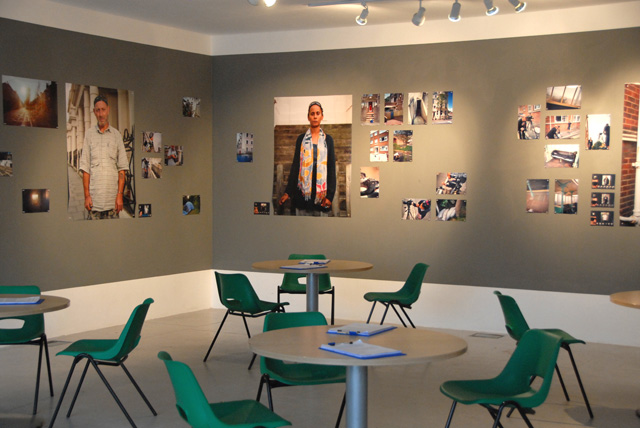
Installation view of Assembly by Anthony Luvera, Phoenix Gallery, Brighton Photo Fringe, 2014
The quote by Spence and Dennett, written in 1986, is an observation about the network of practices and projects broadly described as a community photography movement. They forewarned of the danger that people working within the field may continue to try to reinvent the wheel, because they are not necessarily learning from the accounts of those who have worked before them. Their reflections about this phenomenon have stayed with me since I first read it around 20 years ago, and was certainly an impetus to create Photography For Whom?.
NH: I see you are documenting the community photography movements that have happened before.
AL: Yes. One factor in my decision-making around the selection of the historic piece of text is that it presents a practice or a project that is significant but is lesser-known. This first issue begins with Weld, the Westminster Endeavour for Learning and Development, a community project in Birmingham. It was the first place in the UK to advertise for a community photographer. That felt like a useful and interesting starting point. The text is written by a Swiss cultural anthropologist called Heinz Nigg, who spent a year with the project shortly after the post was taken up by a person called Jon Stewart. Nigg’s writing is a thoughtful account of the work he saw taking place at Weld, told through the lens of his observations, interviews with Stewart and with the participants. The Weld project was a place where a number of photographers had worked, who have since become quite notable, such as Vanley Burke, as well as Derek Bishton, Brian Homer and John Reardon, who were co-founders of the influential Ten.8 and the creators of the Handsworth self-portrait, which is an excellent example of community photography.
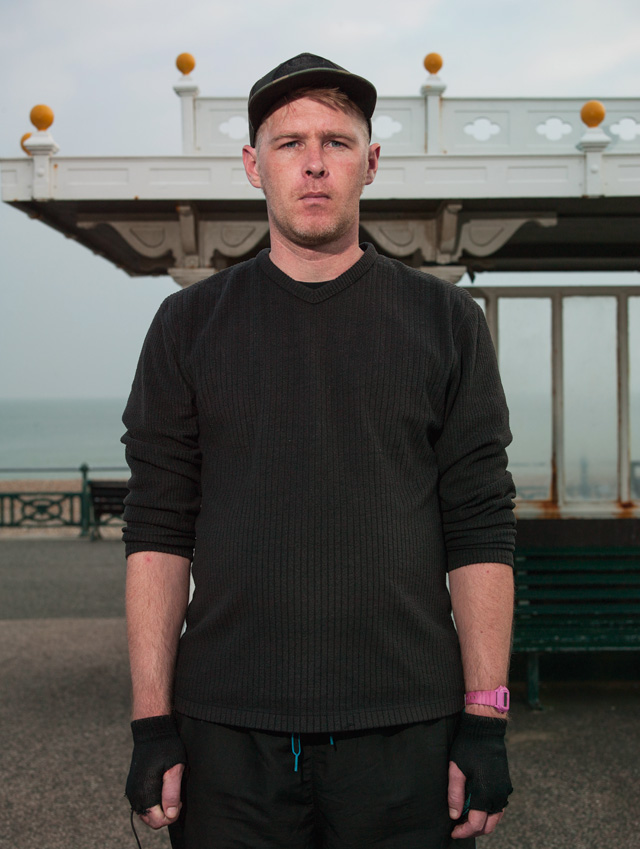
Assisted Self-Portrait of Gerald Mclaverty from Assembly (2013-2014) by Anthony Luvera.
NH: Excellent. Thank you for mentioning the first essay in the journal. I enjoyed reading that one and also the next essay, from which I gathered that community photography emerged in the 70s, through a belief in the democratic potential of art. By the 90s, the humanistic ethos was very different to the celebrity-oriented movement of the Young British Artists. Now we are in the 21st century, the movement is still influential in today’s digital world, where people can make images of themselves on smartphones. How do you think the influence of community photography can frame our understanding of photography today in light of the fact that technology is changing how we make images?
AL: In my view, one of the things that is notable about socially engaged photography today is how it sits within a broader movement of contemporary art and cultural production, where forms of social practice that engage participants as active contributors to processes of representation are much more prevalent than ever before. I’m thinking about all kinds of creative practices, such as applied dance, applied theatre, social design and participative research within the social sciences, as well as forms of contemporary art. In the US, this way of working is usually referred to as social practice. Here in the UK, it is often called socially engaged art. Suzanne Lacy has been a real leader in this field: her practice traverses not only still and lens-based media, but often involves performance and public practices with communities. And if we think of Assemble, the Turner Prize-winners from 2015, their work across the fields of art, design and architecture is a form of social practice. Within photography, this is also taking place and has been so for a long time. So, for contemporary socially engaged photographers to be able to mine the history of photography, to look for antecedents and precedents of forms of working with communities, and working with subjects as participants, there is a lot to be learned there.
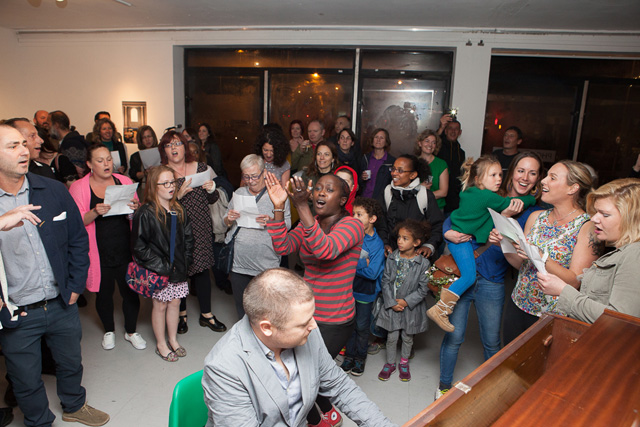
Performance with The Cascade Chorus as part of Assembly, Phoenix Gallery, Brighton Photo Fringe, 2014.
Coming back to your question about photography today, technologically and socially, it has a very different place within society than it did in the 70s. Certainly, people now have access to image-making devices much more so than ever before. With this in mind, there might be an assumption that there is a corresponding increase in visual literacy. However, I would argue this is probably not the case. Visual literacy today is complicated by certain forms of image-making and image-sharing practices that are unique and continually evolving, and this creates all kinds of opportunities and challenges for understanding the role of photographic representation in our everyday lives.
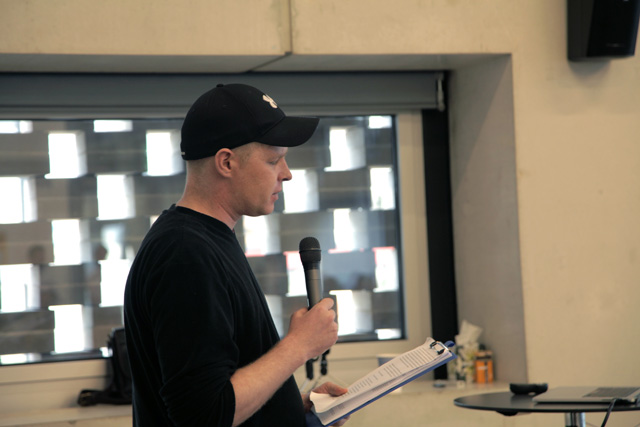
Gerald Mclaverty presenting Frequently Asked Questions at State of the Nation, Museum of Homelessness, Tate Modern, April 2017.
The thing about photography is that it is much more than just a technical skill or a way of using an apparatus; it is a way of telling stories about the world. I believe the more we are able to listen to people telling stories from within their own communities about the way their lives are shaped by the systems and services they are faced with on a daily basis, the more we will be able to gain a view of what society really is like today. With the decline in social care, with the decline in funding for education, and with all of the other cutbacks society is dealing with, it has never been more urgent to listen to and talk about these stories.
NH: Indeed. That leads us on to the good practice you have been involved with. You have collaborated with people who have experienced homelessness in cities and towns across the UK for more than 15 years. You give a voice, in a sense, to people who are often at the margins of society. You very much engage with social issues. To what extent is your work political?
AL: Well, that’s an interesting question. Everything inherently has a politics that resides within it … One of the things I strongly believe in is that everyone already has a voice. Some people are in a position to be able to articulate their views in ways in which it will be heard. The people I work with who are under-represented do have a voice. I hope to use the skills and resources that I’m able to access and organise to shake up preconceptions of the position of those individuals, and in doing so, to reflect on issues of social justice, issues of representation, issues of access. Perhaps, in that sense, that is where the politics of my practice lies.
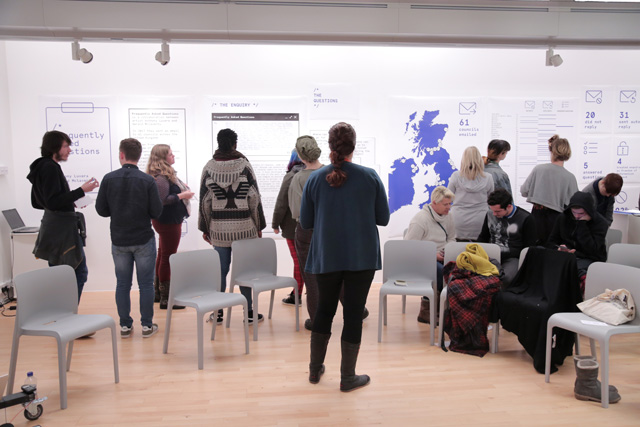
Frequently Asked Questions by Anthony Luvera and Gerald Mclaverty, State of the Nation with Museum of Homelessness Tate Liverpool, 22 - 28 January 2018.
NH: That issue of social justice is pertinent in this day and age.
AL: Absolutely. One project that I’ve been making since 2014 is Frequently Asked Questions, a collaboration with Gerald Mclaverty. I met Gerald while making Assembly with people who experienced homelessness in Brighton between 2012 and 2014.
Assembly consisted of Assisted Self-Portraits, photographs created by participants, digital sound recordings of their experiences of the city, as well as a collaboration with a community choir, the Cascade Chorus. The first exhibition of Assembly, which took place at the Brighton Photo Fringe in 2014, consisted of a soundscape that weaved those recordings together, more than 70 photographs, as well as tables and chairs lent by First Base – a homeless support service – and a piano. Among all of this, I was keen to include information about services for homeless people in towns and cities around the UK. Working with an assistant, we began to compile charity reports, information produced by support services, governmental white papers and the like. What was striking about this material was that often it seemed to largely function as promotional literature, and rarely did it provide useful information for someone at risk of homelessness or experiencing homelessness.
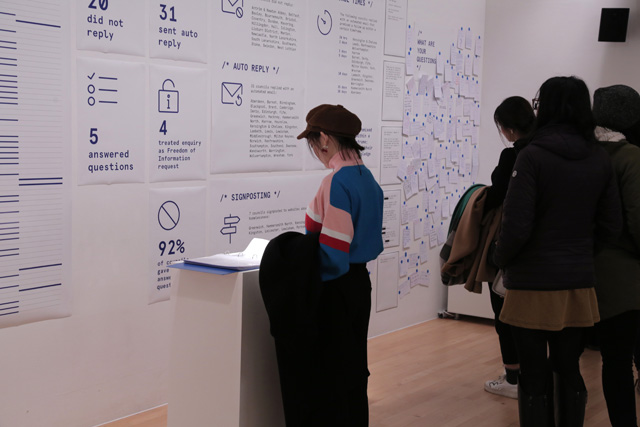
Frequently Asked Questions by Anthony Luvera and Gerald Mclaverty, State of the Nation with Museum of Homelessness Tate Liverpool, 22 – 28 January 2018.
Gerald and I decided to approach this in a different way. We sent an email to housing and homelessness representatives in departments of local authorities around the UK, written from the point of view of someone who was experiencing homelessness and in need of answers – written from Gerald’s point of view. The questions consisted of, “Where can I see a doctor?”, “Where can I see a dentist?” and “Where can I access clothing, footwear and a blanket?” – things like that. We thought we would get useful responses that would provide great information, and actually what we got was largely out-of-office replies that ignored Gerald, the writer of those emails, and his enquiry. That in itself seemed to say as much as anything about the state of provision of services for homeless people.
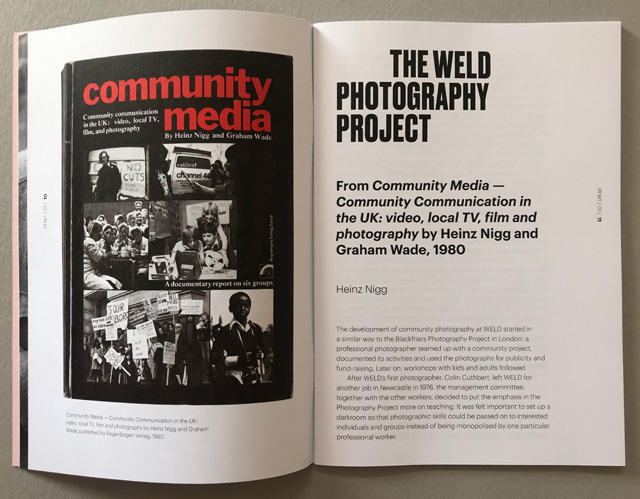
Detail of Photography for Whom? – Issue 1, June 2019.
In 2017, Gerald and I decided to revisit Frequently Asked Questions. We sent out another round of emails to local authorities across the country, compiled the responses and analysed them, and a similar set of data came out. We launched this iteration at Tate Modern as part of State of the Nation by the Museum of Homelessness, and then prepared the material for an exhibition at Tate Liverpool in January 2018. At Tate Liverpool, Frequently Asked Questions was shown as a set of posters in a 13-metre wall display accompanied by public engagement events. These events included a workshop about squatting commercial properties by a collective of squatters from Manchester, and a performance by the Choir With No Name. There was also a panel discussion with the Liverpool Salon, featuring people involved in working for housing and homelessness charities, academics researching welfare reform and consultants working in policy and strategy development, who came from leftwing and rightwing perspectives.
Gerald and I have further progressed our work with Frequently Asked Questions this year. We’re keen to see if there has been a shift in responsiveness by local authorities since the introduction of the Homelessness Reduction Act 2017, which came into effect in April 2018 – the first piece of major legislation around homelessness in 15 years. The law places new duties on local authorities to provide information and assistance, regardless of priority need categories. We’re preparing for an exhibition at the People’s Republic of Stokes Croft in Bristol, in November this year, and a show in London in January 2020, and both will feature thought-provoking public engagement events as part of the work.
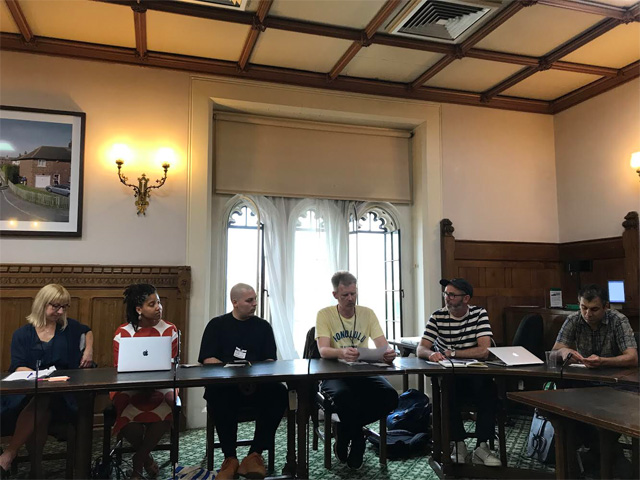
Anthony Luvera and Gerald Mclaverty presenting Frequently Asked Questions, Houses of Parliament, June 2019.
NH: Do you think this highlights the challenges that a homeless person might face, and how they can try to overcome those challenges?
AL: I do, yes. Gerald and I were pleased to be invited to the Houses of Parliament recently. We were asked to present Frequently Asked Questions at a meeting hosted by Neil Coyle, the chair of the all-party parliamentary group on ending homelessness and the MP for Bermondsey and Old Southwark. Interestingly, Southwark was one of the worst offenders in the three iterations of this project. It was great to be able to go with Gerald into the Houses of Parliament, and to provide him with a platform to speak to MPs about the issues at the heart of the work.
NH: Could you sum up the exchange? How did it go?
AL: From my perspective, it felt like a productive conversation. From Gerald’s perspective? He told me: “It was amazing to be there in the Houses of Parliament speaking about our work with people in a position of power to change things. I hope they take it all on board.”
• Photography for Whom? costs £6 and is available from photographyforwhom.com and from selected bookshops.